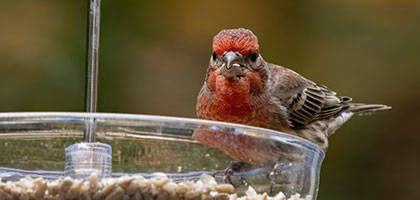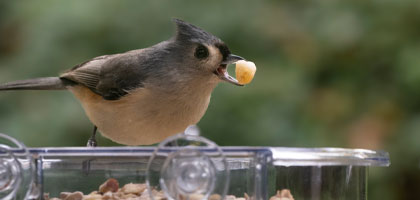Understanding the dietary habits of woodpeckers can be an enriching experience for bird enthusiasts. These fascinating birds are not only known for their pecking behavior but also for their diverse diet. In this article, we will explore whether woodpeckers eat nyjer seed, discuss how to feed woodpeckers, and delve into the broader spectrum of woodpecker foods and backyard birds.
Do Woodpeckers Eat Nyjer Seed?
Nyjer seed, also known as thistle seed, is a popular choice for attracting finches. However, you might wonder if woodpeckers are also drawn to this tiny, oil-rich seed.
Woodpecker Diet Preferences
Woodpeckers primarily feed on insects and larvae found beneath tree bark. Their strong beaks are perfectly designed for chiseling into wood to reach these hidden treats. However, their diet isn't limited to just insects. Woodpeckers also enjoy fruits, nuts, and seeds.
Woodpeckers and Nyjer Seed
While woodpeckers are not typically attracted to nyjer seed as their primary food source, they may occasionally eat it if other food options are scarce. Nyjer seed is more likely to attract smaller birds, such as finches and siskins, due to its size and nutritional content. So, while woodpeckers might not seek out nyjer seed, they won't ignore it if it's available and other preferred foods are not.
Feeding Woodpeckers in Your Backyard
Attracting woodpeckers to your backyard involves understanding their dietary preferences and providing suitable food options. Here's how you can create a woodpecker-friendly environment:
Providing the Right Food
To attract woodpeckers, consider offering a variety of foods that they naturally enjoy. Some popular choices include:
- Suet: This high-energy food is a favorite among woodpeckers. You can find suet cakes in various flavors, often mixed with seeds, nuts, or fruits.
- Peanuts: Both shelled and unshelled peanuts are great options for woodpeckers. They provide a good source of protein and fats.
- Sunflower Seeds: Black oil sunflower seeds are preferred due to their high oil content, which provides essential energy.
- Fruits: Offer chopped apples, oranges, or berries on a platform feeder to attract woodpeckers.
Setting Up Feeders
When setting up feeders for woodpeckers, consider the following tips:
- Location: Place feeders near trees or shrubs to provide a natural environment for woodpeckers.
- Stability: Ensure feeders are securely mounted to prevent them from swinging in the wind, which might deter birds.
- Variety: Provide multiple types of feeders, such as suet cages and platform feeders, to cater to different feeding habits.
The Importance of Water
In addition to food, water is essential for attracting woodpeckers and other backyard birds. A birdbath or small fountain can provide the hydration woodpeckers need, especially during hot weather or dry spells. Ensure the water source is clean and replenished regularly to maintain a healthy environment for your feathered visitors.
Understanding Woodpecker Habitats
To further entice woodpeckers, consider the natural habitat they prefer. These birds thrive in areas with mature trees and dead wood, which provide ample feeding and nesting opportunities. If possible, allow dead trees or branches to remain in your yard, as they serve as valuable resources for woodpeckers and other wildlife.
Types of Woodpeckers You Might See
Several species of woodpeckers might visit your backyard, depending on your location. Some common types include:
- Downy Woodpecker: The smallest woodpecker in North America, known for its black and white plumage and small size.
- Hairy Woodpecker: Similar in appearance to the Downy Woodpecker but larger, with a longer bill.
- Northern Flicker: Recognizable by its brown plumage with black spots and a distinctive white rump.
- Pileated Woodpecker: The largest woodpecker in North America, easily identified by its striking red crest and black and white coloring.
Woodpecker Behavior to Observe
Woodpeckers are fascinating birds to watch, and their behaviors can provide insight into their feeding habits and preferences. Here are a few behaviors to observe:
Drumming
Woodpeckers are known for their drumming behavior, which is used to establish territory and communicate with potential mates. This rhythmic pecking is often mistaken for feeding activity but serves a different purpose.
Foraging
Watch how woodpeckers forage for food by pecking at tree bark and probing crevices for insects. This behavior showcases their adaptability and resourcefulness in finding sustenance.
Social Interactions
While woodpeckers are generally solitary birds, you may observe them interacting with other species, especially around feeders. Pay attention to their social dynamics and how they share feeding spaces with other birds.
Conclusion
Feeding woodpeckers and understanding their dietary habits can enhance your backyard birdwatching experience. While woodpeckers are not primarily attracted to nyjer seed, providing a variety of foods, such as suet, peanuts, and sunflower seeds, can entice them to visit your yard. By creating a welcoming environment with the right food, water, and natural habitat, you can enjoy the presence of these fascinating birds and observe their unique behaviors.
With the right approach, you'll soon find your backyard becoming a haven for woodpeckers and other beautiful birds, making your birdwatching experience all the more rewarding. So, stock up on woodpecker-friendly foods, set up your feeders, and get ready to enjoy the vibrant world of backyard birds.




